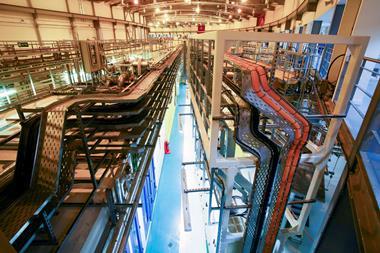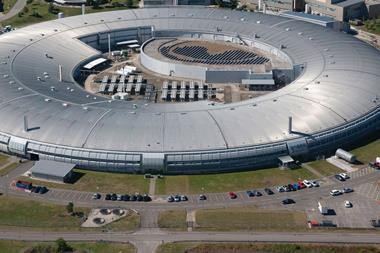Diamond Light Source, the UK’s synchrotron, has generated a ‘fantastic return on investment’ since it became operational in 2007. That’s according to a new study that values its socio-economic impacts at around £1.8 billion with each taxpayer contributing £2.45 a year towards it.
Synchrotrons are used in imaging and non-destructive testing of materials and structures, as well as in drug discovery and development. Set up in 2002, Diamond is an independent not-for-profit company, a joint venture between the UKRI’s Science and Technology Facilities Council and the Wellcome Trust, which own 86% and 14% of the facility, respectively. Diamond has received £1.2 billion in investment over 14 years and hosted 14,000 users.
‘[£1.8 billion] is almost definitely an under-estimate,’ comments chief executive of Diamond, Andrew Harrison. ‘For example, it is very difficult to monetise the value to industry from increased profits because of confidentiality issues.’ The benefits will continue to emerge for many years to come, he adds.
The study by research consultancy Technopolis and Diamond found that work conducted at the synchrotron resulted in 9600 research articles calculated to have a cumulative impact to date of £677 million, patents citing Diamond contributions valued at £10.2 billion (2018 prices), 28 cases of breakthrough science, and software and applications worth £51.3 million. ‘Softer’ impacts include training worth £8.8 million, ranging from teaching researchers to use a specific beamline to supporting software for data collection and analysis with beneficiaries ranging from apprentices to postdoctoral students.

‘It is the facilities in the UK that really make the difference and make us a world leader,’ comments John McGeehan, professor of structural biology at the University of Portsmouth. His team has used Diamond to study the bacterial enzyme PETase, which digests plastic. ‘Diamond’s I23 [long-wave macromolecular crystallography] beamline is unique in the world. It allowed us to solve the 3D structure of the PET-degrading enzyme, first found in plastic dumps in Japan in 2016. Three years ago it was the highest resolution image of the enzyme measured and remains so today. Having this information allows us to understand how the enzyme works, and how to make it work faster and better.’
Shine on
As a result, the team has been able to visualise the active site of the enzyme and how it consumes plastic. The researchers discovered that the active site was slightly wider than cutinase, a similar enzyme that bacteria use to break down natural plant polyesters. ‘The technology leading from this research means plastic waste can be broken down and put back together into bottles (infinite recycling), or can be made into higher value products such as resins for wind turbine blades,’ says McGeehan. Patents are pending.
National facilities such as Diamond drive up expertise in industry, and are key to increasing understanding in technology and experimental output, says Dave Rugg, formerly of Rolls Royce and a regular user of Diamond. ‘All in all, they create long-term and sustainable innovation and profitability,’ he adds.
Rolls-Royce’s activities have focused on understanding the residual stress profile of materials used in components, which has then helped the company to demonstrate product capability when bidding for new contracts, and provided a better understanding of the service life of products in use, helping to reduce repair bills, says Rugg.
Diamond’s beamlines allow non-destructive measurements of the internal stresses and strains of components up to two tonnes in mass, and longer than a metre. Most synchrotron beamlines are focused on microscopic samples. Rolls-Royce used energy dispersive x-ray diffraction to assess the performance of fan blade surface treatments at preventing cracks. ‘Fan blades are highly stressed components and we needed them to last longer. We were able to see complex geometries in these big components with very good spatial depth resolution,’ explains Rugg. The stress profiles we produced gave us the confidence in our manufacturing output and we achieved massive increases in component lifetimes.’












No comments yet